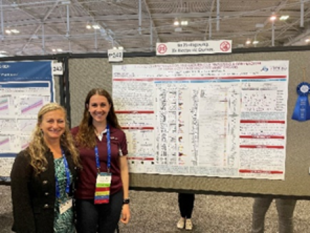Science Leadership

Superfund Research Program (SRP) staff and grantees are committed to advancing SRP research by presenting innovative findings, tools, and technologies to stakeholders in academia, government, and local communities.
SRP Health Scientist Administrator Michelle Heacock, Ph.D., was named Acting Chief of the Hazardous Substances Research Branch and Director of the SRP.
SRP grantees were in the spotlight during the 2023 Society of Toxicology Annual Meeting in Nashville, Tennessee. Among those recognized were Pawel Lorkiewicz, Ph.D., and Dan Conklin, Ph.D., of the University of Louisville SRP Center; Theodore Slotkin, Ph.D., and Edward Levin, Ph.D., of the Duke SRP Center; Oregon State University SRP Center Director Robyn Tanguay, Ph.D., and researcher Lisa Truong, Ph.D.; Jamie Dewitt, Ph.D., of East Carolina University and co-investigator with the North Carolina State University SRP Center (NCSU); Kjersti Aagaard, M.D., Ph.D., of the Baylor College of Medicine SRP Center; and Massachusetts Institute of Technology SRP Center Director Bevin Engelward, Sc.D. More than 20 SRP Trainees were also recognized with awards.
Upal Ghosh, Ph.D., of the University of Maryland, Baltimore County was featured in an NIEHS Story of Success highlighting his work to develop more effective clean up strategies for polychlorinated biphenyls in aquatic systems.

Mallery Quetawki, the artist in residence with the University of New Mexico SRP Center, was recognized in a Partnerships for Environmental Public Health Grantee Highlight. The story focuses on her use of Tribal art and symbolism to make complex scientific concepts accessible to Native American communities affected by hazardous mining waste.
Researchers led by Kim Anderson, Ph.D., at the Oregon State University (OSU) SRP Center developed a simple, non-invasive approach to monitor personal chemical exposures using silicone wristbands. The highly sensitive wristbands can be used to measure exposure to low levels of hundreds of chemicals, offering a unique tool to better understand the complex, realistic mixtures people may be exposed to.
Bill Suk, Ph.D., former director of SRP, co-authored a comprehensive report on plastics and human health .
David Reif, Ph.D., formerly of the NCSU SRP Center, is now chief of the Predictive Toxicology Branch in the NIEHS Division on Translational Toxicology.
to Top



